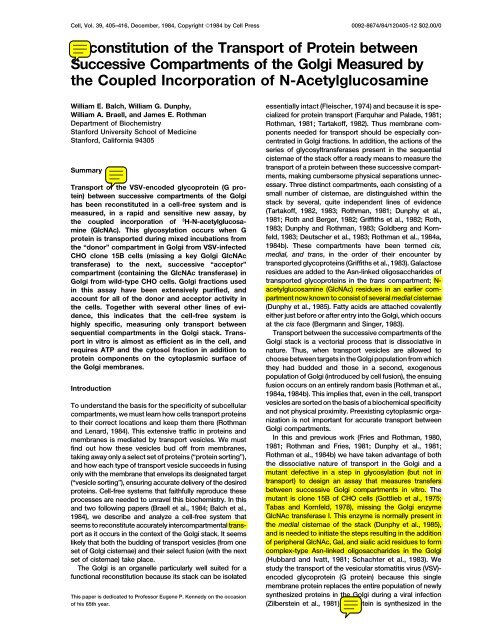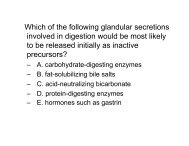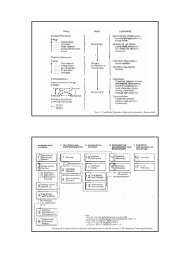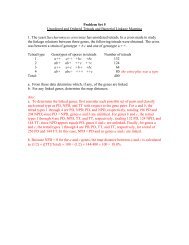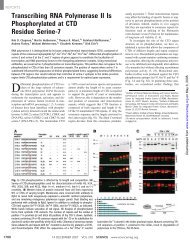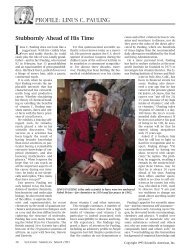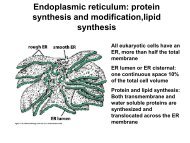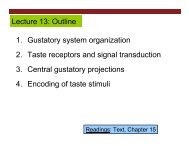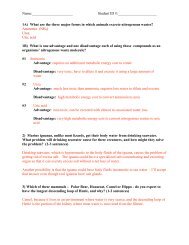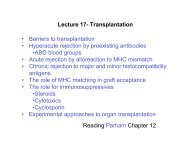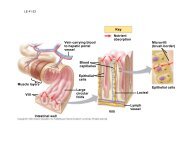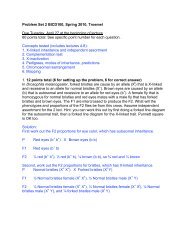Reconstitution of the Transport of Protein between Successive ...
Reconstitution of the Transport of Protein between Successive ...
Reconstitution of the Transport of Protein between Successive ...
You also want an ePaper? Increase the reach of your titles
YUMPU automatically turns print PDFs into web optimized ePapers that Google loves.
Cell, Vol. 39, 405–416, December, 1984, Copyright ©1984 by Cell Press 0092-8674/84/120405-12 $02.00/0<br />
<strong>Reconstitution</strong> <strong>of</strong> <strong>the</strong> <strong>Transport</strong> <strong>of</strong> <strong>Protein</strong> <strong>between</strong><br />
<strong>Successive</strong> Compartments <strong>of</strong> <strong>the</strong> Golgi Measured by<br />
<strong>the</strong> Coupled Incorporation <strong>of</strong> N-Acetylglucosamine<br />
William E. Balch, William G. Dunphy,<br />
William A. Braell, and James E. Rothman<br />
Department <strong>of</strong> Biochemistry<br />
Stanford University School <strong>of</strong> Medicine<br />
Stanford, California 94305<br />
Summary<br />
<strong>Transport</strong> <strong>of</strong> <strong>the</strong> VSV-encoded glycoprotein (G pro-<br />
tein) <strong>between</strong> successive compartments <strong>of</strong> <strong>the</strong> Golgi<br />
has been reconstituted in a cell-free system and is<br />
measured, in a rapid and sensitive new assay, by<br />
<strong>the</strong> coupled incorporation <strong>of</strong> 3<br />
H-N-acetylglucosamine<br />
(GlcNAc). This glycosylation occurs when G<br />
protein is transported during mixed incubations from<br />
<strong>the</strong> “donor” compartment in Golgi from VSV-infected<br />
CHO clone 15B cells (missing a key Golgi GlcNAc<br />
transferase) to <strong>the</strong> next, successive “acceptor”<br />
compartment (containing <strong>the</strong> GlcNAc transferase) in<br />
Golgi from wild-type CHO cells. Golgi fractions used<br />
in this assay have been extensively purified, and<br />
account for all <strong>of</strong> <strong>the</strong> donor and acceptor activity in<br />
<strong>the</strong> cells. Toge<strong>the</strong>r with several o<strong>the</strong>r lines <strong>of</strong> evi-<br />
dence, this indicates that <strong>the</strong> cell-free system is<br />
highly specific, measuring only transport <strong>between</strong><br />
sequential compartments in <strong>the</strong> Golgi stack. <strong>Transport</strong><br />
in vitro is almost as efficient as in <strong>the</strong> cell, and<br />
requires ATP and <strong>the</strong> cytosol fraction in addition to<br />
protein components on <strong>the</strong> cytoplasmic surface <strong>of</strong><br />
<strong>the</strong> Golgi membranes.<br />
Introduction<br />
To understand <strong>the</strong> basis for <strong>the</strong> specificity <strong>of</strong> subcellular<br />
compartments, we must learn how cells transport proteins<br />
to <strong>the</strong>ir correct locations and keep <strong>the</strong>m <strong>the</strong>re (Rothman<br />
and Lenard, 1984). This extensive traffic in proteins and<br />
membranes is mediated by transport vesicles. We must<br />
find out how <strong>the</strong>se vesicles bud <strong>of</strong>f from membranes,<br />
taking away only a select set <strong>of</strong> proteins (“protein sorting”),<br />
and how each type <strong>of</strong> transport vesicle succeeds in fusing<br />
only with <strong>the</strong> membrane that envelops its designated target<br />
(“vesicle sorting”), ensuring accurate delivery <strong>of</strong> <strong>the</strong> desired<br />
proteins. Cell-free systems that faithfully reproduce <strong>the</strong>se<br />
processes are needed to unravel this biochemistry. In this<br />
and two following papers (Braell et al., 1984; Balch et al.,<br />
1984), we describe and analyze a cell-free system that<br />
seems to reconstitute accurately intercompartmental trans-<br />
port as it occurs in <strong>the</strong> context <strong>of</strong> <strong>the</strong> Golgi stack. It seems<br />
likely that both <strong>the</strong> budding <strong>of</strong> transport vesicles (from one<br />
set <strong>of</strong> Golgi cisternae) and <strong>the</strong>ir select fusion (with <strong>the</strong> next<br />
set <strong>of</strong> cisternae) take place.<br />
The Golgi is an organelle particularly well suited for a<br />
functional reconstitution because its stack can be isolated<br />
This paper is dedicated to Pr<strong>of</strong>essor Eugene P. Kennedy on <strong>the</strong> occasion<br />
<strong>of</strong> his 65th year.<br />
essentially intact (Fleischer, 1974) and because it is specialized<br />
for protein transport (Farquhar and Palade, 1981;<br />
Rothman, 1981; Tartak<strong>of</strong>f, 1982). Thus membrane components<br />
needed for transport should be especially concentrated<br />
in Golgi fractions. In addition, <strong>the</strong> actions <strong>of</strong> <strong>the</strong><br />
series <strong>of</strong> glycosyltransferases present in <strong>the</strong> sequential<br />
cisternae <strong>of</strong> <strong>the</strong> stack <strong>of</strong>fer a ready means to measure <strong>the</strong><br />
transport <strong>of</strong> a protein <strong>between</strong> <strong>the</strong>se successive compartments,<br />
making cumbersome physical separations unnecessary.<br />
Three distinct compartments, each consisting <strong>of</strong> a<br />
small number <strong>of</strong> cisternae, are distinguished within <strong>the</strong><br />
stack by several, quite independent lines <strong>of</strong> evidence<br />
(Tartak<strong>of</strong>f, 1982, 1983; Rothman, 1981; Dunphy et al.,<br />
1981; Roth and Berger, 1982; Griffiths et al., 1982; Roth,<br />
1983; Dunphy and Rothman, 1983; Goldberg and Korn-<br />
feld, 1983; Deutscher et al., 1983; Rothman et al., 1984a,<br />
1984b). These compartments have been termed cis,<br />
medial, and trans, in <strong>the</strong> order <strong>of</strong> <strong>the</strong>ir encounter by<br />
transported glycoproteins (Griffiths et al., 1983). Galactose<br />
residues are added to <strong>the</strong> Asn-linked oligosaccharides <strong>of</strong><br />
transported glycoproteins in <strong>the</strong> trans compartment; N-<br />
acetylglucosamine (GlcNAc) residues in an earlier com-<br />
partment now known to consist <strong>of</strong> several medial cisternae<br />
(Dunphy et al., 1985). Fatty acids are attached covalently<br />
ei<strong>the</strong>r just before or after entry into <strong>the</strong> Golgi, which occurs<br />
at <strong>the</strong> cis face (Bergmann and Singer, 1983).<br />
<strong>Transport</strong> <strong>between</strong> <strong>the</strong> successive compartments <strong>of</strong> <strong>the</strong><br />
Golgi stack is a vectorial process that is dissociative in<br />
nature. Thus, when transport vesicles are allowed to<br />
choose <strong>between</strong> targets in <strong>the</strong> Golgi population from which<br />
<strong>the</strong>y had budded and those in a second, exogenous<br />
population <strong>of</strong> Golgi (introduced by cell fusion), <strong>the</strong> ensuing<br />
fusion occurs on an entirely random basis (Rothman et al.,<br />
1984a, 1984b). This implies that, even in <strong>the</strong> cell, transport<br />
vesicles are sorted on <strong>the</strong> basis <strong>of</strong> a biochemical specificity<br />
and not physical proximity. Preexisting cytoplasmic orga-<br />
nization is not important for accurate transport <strong>between</strong><br />
Golgi compartments.<br />
In this and previous work (Fries and Rothman, 1980,<br />
1981; Rothman and Fries, 1981; Dunphy et al., 1981;<br />
Rothman et al., 1984b) we have taken advantage <strong>of</strong> both<br />
<strong>the</strong> dissociative nature <strong>of</strong> transport in <strong>the</strong> Golgi and a<br />
mutant defective in a step in glycosylation (but not in<br />
transport) to design an assay that measures transfers<br />
<strong>between</strong> successive Golgi compartments in vitro. The<br />
mutant is clone 15B <strong>of</strong> CHO cells (Gottlieb et al., 1975;<br />
Tabas and Kornfeld, 1978), missing <strong>the</strong> Golgi enzyme<br />
GlcNAc transferase I. This enzyme is normally present in<br />
<strong>the</strong> medial cisternae <strong>of</strong> <strong>the</strong> stack (Dunphy et al., 1985),<br />
and is needed to initiate <strong>the</strong> steps resulting in <strong>the</strong> addition<br />
<strong>of</strong> peripheral GlcNAc, Gal, and sialic acid residues to form<br />
complex-type Asn-linked oligosaccharides in <strong>the</strong> Golgi<br />
(Hubbard and Ivatt, 1981; Schachter et al., 1983). We<br />
study <strong>the</strong> transport <strong>of</strong> <strong>the</strong> vesicular stomatitis virus (VSV)-<br />
encoded glycoprotein (G protein) because this single<br />
membrane protein replaces <strong>the</strong> entire population <strong>of</strong> newly<br />
syn<strong>the</strong>sized proteins in <strong>the</strong> Golgi during a viral infection<br />
(Zilberstein et al., 1981). G protein is syn<strong>the</strong>sized in <strong>the</strong>
Cell<br />
406<br />
Figure 1. Assay for <strong>Transport</strong> <strong>of</strong> a <strong>Protein</strong> <strong>between</strong> <strong>Successive</strong> Golgi Compartments in Vitro, Based on a <strong>Transport</strong>-Coupled Glycosylation<br />
A donor fraction containing Golgi membranes is prepared from VSV-infected clone 15B cells (a mutant cell line lacking UDP-GlcNAc glycosyltransferase I—<br />
GlcNAc Trase). This fraction is incubated with an acceptor fraction also containing Golgi, but prepared from uninfected wild-type cells. Incorporation <strong>of</strong> 3 H-<br />
GlcNAc (from UDP- 3 H-GlcNAc) into G protein occurs when G protein is transferred in a dissociative fashion <strong>between</strong> <strong>the</strong> two Golgi. Specifically, <strong>the</strong> assay measures<br />
transfers <strong>of</strong> G protein into <strong>the</strong> acceptor compartment in wild-type Golgi housing <strong>the</strong> GlcNAc transferase (corresponding to medial cisternae) from <strong>the</strong> immediately<br />
prior donor compartment (currently believed to be cis cisternae or vesicles derived from <strong>the</strong>se) present in <strong>the</strong> 15B Golgi. This dissociative transfer (solid arrows)<br />
results from <strong>the</strong> random choice <strong>of</strong> target cisternae from among <strong>the</strong> two Golgi populations. Corresponding transfers should also occur within <strong>the</strong> 15B Golgi (dashed<br />
arrow) butare notrecorded in<strong>the</strong> assaybecause <strong>of</strong> <strong>the</strong>lack <strong>of</strong><strong>the</strong> GlcNActransferase in 15BGolgi. Incorporationinto Gprotein ismeasured directly byimmunoprecipitation.Thepolypeptide<br />
<strong>of</strong>Gproteinwill span<strong>the</strong>Golgimembrane beforeandafter<strong>the</strong>transfer. Thetrimmedcoreoligosaccharide containingtwoN-acetylglucosamine<br />
(GlcNAc) () and 5 Man residues (), is <strong>the</strong> immediate substrate for GlcNAc transferase I. It is not clear whe<strong>the</strong>r this trimming occurs upon arrival in <strong>the</strong> acceptor<br />
compartment or before departure from <strong>the</strong> prior donor compartment, but <strong>the</strong> process is diagrammed as if <strong>the</strong> latter were <strong>the</strong> case. 3 H-GlcNAc ().<br />
rough endoplasmic reticulum (ER), and it passes through are certain to be distinct at a molecular level, this is an<br />
<strong>the</strong> Golgi en route to <strong>the</strong> plasma membrane, from which it important advantage.<br />
is incorporated into <strong>the</strong> envelope <strong>of</strong> budding virions.<br />
In this paper we report a much more rapid, quantitative,<br />
For <strong>the</strong> assay, a Golgi-containing fraction is prepared and flexible form <strong>of</strong> this assay, as well as <strong>the</strong> extensive<br />
from VSV-infected 15B cells. When this fraction is incu- purification <strong>of</strong> active and stable donor- and acceptorcontaining<br />
bated, transport <strong>of</strong> G protein into <strong>the</strong> medial compartment<br />
Golgi fractions, opening <strong>the</strong> way to an analysis<br />
may well occur, but <strong>of</strong> course GlcNAc cannot be added <strong>of</strong> <strong>the</strong> mechanisms <strong>of</strong> transfer. In <strong>the</strong> second paper <strong>of</strong> this<br />
to G protein, since <strong>the</strong> needed enzyme is missing from series (Braell et al., 1984), we will report <strong>the</strong> use <strong>of</strong> this<br />
<strong>the</strong> 15B cell Golgi. However, when a Golgi fraction from improved assay to localize <strong>the</strong> transferred G protein by<br />
uninfected wild-type CHO cells is included (Figure 1), electron microscopic autoradiography to morphologically<br />
GlcNAc can be added to G protein following a dissociative intact Golgi stacks, derived from <strong>the</strong> wild-type and not<br />
form <strong>of</strong> this transfer, into <strong>the</strong> medial (“acceptor”) compartment<br />
from <strong>the</strong> 15B Golgi population. This finding implies that <strong>the</strong><br />
<strong>of</strong> <strong>the</strong> wild-type Golgi. Provided <strong>the</strong> in vivo specificity transport in vitro is highly specific, and involves intact Golgi<br />
<strong>of</strong> membrane traffic and fusion is preserved in vitro, <strong>the</strong> stacks. In <strong>the</strong> third paper (Balch et al., 1984), we exploit<br />
incorporation <strong>of</strong> GlcNAc into G protein will be an exclusive two-stage incubations and <strong>the</strong> selective inhibitory effects<br />
measure <strong>of</strong> transfers <strong>of</strong> G protein <strong>between</strong> successive <strong>of</strong> N-ethylmaleimide to reveal two successive kinetic inter-<br />
compartments in <strong>the</strong> Golgi (<strong>the</strong>se compartments residing mediates in <strong>the</strong> transport process. On <strong>the</strong> basis <strong>of</strong> electron<br />
in different Golgi populations), even when <strong>the</strong>se Golgi microscopy, <strong>the</strong>se seem to represent intermediate stages<br />
membranes are present as a minor fraction within a crude in <strong>the</strong> budding and fusion <strong>of</strong> transport vesicles.<br />
homogenate. In fact, <strong>the</strong> cell-free system seems to respect<br />
<strong>the</strong> same compartment boundaries that exist in <strong>the</strong> cell, Results<br />
exhibiting an appropriate specificity (Fries and Rothman,<br />
1981; Dunphy et al., 1981; Rothman et al., 1984b). The G <strong>Transport</strong>-Coupled Incorporation <strong>of</strong> 3 H-GlcNAc into<br />
protein transported to <strong>the</strong> acceptor compartment thus G <strong>Protein</strong><br />
originates within <strong>the</strong> immediately prior “donor” compart- In previous work we monitored <strong>the</strong> transport-coupled adment<br />
present in <strong>the</strong> Golgi population from <strong>the</strong> infected 15B dition <strong>of</strong> GlcNAc to G protein indirectly, as judged by <strong>the</strong><br />
cells, currently believed to be <strong>the</strong> cis portion <strong>of</strong> <strong>the</strong> stack. ensuing resistance <strong>of</strong> <strong>the</strong> oligosaccharide to endoglycosi-<br />
Constructing an assay that measures <strong>the</strong> activities <strong>of</strong> donor dase H (Fries and Rothman, 1981). This procedure reand<br />
acceptor compartments in different Golgi fractions quired that <strong>the</strong> polypeptide backbone <strong>of</strong> G be radioactively<br />
permits <strong>the</strong>ir separate biochemical manipulation prior to labeled in vivo, and it necessitated <strong>the</strong> use <strong>of</strong> SDS gels<br />
incubations. Since donor activities (e.g. <strong>the</strong> budding <strong>of</strong> and autoradiography for analysis, taking several days. A<br />
vesicles) and acceptor activities (e.g. <strong>the</strong> fusion <strong>of</strong> vesicles) more rapid, sensitive, and flexible assay was needed to
<strong>Reconstitution</strong> <strong>of</strong> <strong>Protein</strong> <strong>Transport</strong><br />
407<br />
enable a fur<strong>the</strong>r analysis and fractionation. We reasoned<br />
that by measuring <strong>the</strong> transport-coupled incorporation <strong>of</strong><br />
3<br />
H-GlcNAc into G protein directly (from UDP- 3 H-GlcNAc),<br />
<strong>the</strong>se needs could be fulfilled (Figure 1). The donor fraction<br />
can be prepared from unlabeled VSV-infected 15B cells,<br />
and <strong>the</strong> 3 H-labeled G protein can be retained on filters as<br />
a rapidly formed immunoprecipitate and counted.<br />
Postnuclear supernatants <strong>of</strong> VSV-infected CHO clone<br />
15B and <strong>of</strong> uninfected wild-type cells were prepared as<br />
described in Experimental Procedures. These crude fractions<br />
were incubated toge<strong>the</strong>r in <strong>the</strong> presence <strong>of</strong> ATP, an<br />
ATP regenerating system, and UDP- 3 H-GlcNAc. Assays<br />
were terminated by <strong>the</strong> addition <strong>of</strong> detergent to solubilize<br />
<strong>the</strong> membranes, followed by anti–G protein antiserum. The<br />
immunoprecipitates (formed within 45 min at 37C or<br />
overnight at 4C) were collected on a Millipore filter,<br />
washed, and counted. As shown in Figure 2, a timedependent<br />
incorporation <strong>of</strong> 3 H-GlcNAc into G protein was<br />
observed during <strong>the</strong> incubation. Only trace levels <strong>of</strong> 3 H<br />
were retained on <strong>the</strong> filter when <strong>the</strong> anti–G protein serum Figure 2. Incorporation <strong>of</strong> 3 H-GlcNAc into G <strong>Protein</strong> during Incubations <strong>of</strong> <strong>the</strong><br />
was replaced with a preimmune serum, implying that all <strong>of</strong><br />
PNS <strong>of</strong> VSV-Infected 15B Cells with <strong>the</strong> PNS <strong>of</strong> Uninfected Wild-Type<br />
Cells<br />
<strong>the</strong> 3 H retained had been in G protein. The time course <strong>of</strong><br />
Crude homogenates <strong>of</strong> VSV-infected clone 15B cells and wild-type cells<br />
incorporation <strong>of</strong> 3 H-GlcNAc into G protein was very similar<br />
were prepared as described in Experimental Procedures. The homogenates<br />
to that previously reported for <strong>the</strong> transport-coupled proc- were centrifuged at 600 g for 5 min, yielding a PNS fraction (about 15<br />
essing <strong>of</strong> G protein to <strong>the</strong> EndoH-resistant form in mg/ml protein). Then, 35 g <strong>of</strong> <strong>the</strong> PNS from <strong>the</strong> VSV-infected clone 15B<br />
vitro (Fries and Rothman, 1981).<br />
cells and 70 g <strong>of</strong> <strong>the</strong> PNS from uninfected wild-type cells were incubated<br />
for increasing times under standard assay conditions (see Experimental<br />
Analysis <strong>of</strong> a 60 min incubation using SDS-gel electro-<br />
Procedures) except no cytosol was added. The incorporation <strong>of</strong> 3 H-GlcNAc<br />
phoresis revealed that G protein is <strong>the</strong> major protein into G protein was measured by collecting <strong>the</strong> immunoprecipitate on<br />
species labeled (Figure 2 inset, lane a), accounting for Millipore filters, using anti–G protein serum () or a preimmune serum (),<br />
as in Experimental Procedures. For <strong>the</strong> inset autoradiograph, incubations<br />
about 50% <strong>of</strong> <strong>the</strong> total radiolabel incorporated. The imwere<br />
as described above for 60 min, followed by SDS gel electrophoresis.<br />
munoprecipitate contained G protein as <strong>the</strong> only radiola-<br />
(Lane a) The incubation was terminated by <strong>the</strong> addition <strong>of</strong> 50 l <strong>of</strong> gel<br />
beled protein species (Figure 2, inset, lane b); G protein sample buffer (GSB; 0.1 M Tris-HCl, pH 6.8; 2% sodium dodecylsulfate; 30<br />
was quantitatively immunoprecipitated. No radiolabeled mM dithiothreitol; 10% glycerol; 1 g/ml bromophenol blue), and boiled<br />
prior to SDS gel electrophoresis. (Lanes b and c) Incubations were termiproteins<br />
were observed with preimmune serum (Figure 2<br />
nated by addition <strong>of</strong> 50 l detergent buffer (DB, see Experimental Proceinset,<br />
lane c). The incorporation <strong>of</strong> 3 H-GlcNAc in incubadures)<br />
and 15 l <strong>of</strong> anti–G protein serum (lane b) or 15 l preimmune<br />
tions employing crude postnuclear supernatants exhibits serum (lane c). After an overnight incubation on ice, 25 l <strong>of</strong> a 10%<br />
all <strong>of</strong> <strong>the</strong> properties detailed in <strong>the</strong> following sections for suspension <strong>of</strong> Staph A cells (Pansorbin, Calbiochem Corp., previously<br />
washed twice with washing buffer, (see Experimental Procedures) was<br />
incubations with sucrose-gradient-purified donor and acadded.<br />
After 1 hr on ice, <strong>the</strong> cells were pelleted in a micr<strong>of</strong>uge in 15 sec,<br />
ceptor Golgi fractions (data not shown). For example, no<br />
washed twice with 1 ml each <strong>of</strong> washing buffer, resuspended in 50 l <strong>of</strong><br />
3<br />
H was incorporated into G protein when <strong>the</strong> postnuclear water prior to addition <strong>of</strong> 50 l GBS, and boiled. The cells were <strong>the</strong>n<br />
supernatant <strong>of</strong> uninfected 15B cells replaced <strong>the</strong> correpolyacrylamide<br />
gel according to <strong>the</strong> method <strong>of</strong> Laemmli (1970). The dried<br />
pelleted for 3 min, and <strong>the</strong> supernatants were electrophoresed in a 10%<br />
sponding fraction from infected cells.<br />
gel was autoradiographed with fluorographic enhancement for 7 days.<br />
in Golgi, with identical properties and requirements. The<br />
following sections document <strong>the</strong>se and related points.<br />
Since <strong>the</strong> G protein should originate within <strong>the</strong> Golgi<br />
membranes <strong>of</strong> <strong>the</strong> homogenate <strong>of</strong> <strong>the</strong> VSV-infected 15B<br />
cells, fractionation <strong>of</strong> <strong>the</strong> homogenate on a density gradient<br />
should yield a Golgi-rich fraction containing all <strong>of</strong> <strong>the</strong> donor<br />
activity. The crude homogenate, prepared by breaking<br />
cells in <strong>the</strong> presence <strong>of</strong> 0.25 M sucrose and 10 mM Tris-<br />
HCl (pH 7.4), was adjusted to 1.4 M sucrose and 1 mM<br />
EDTA and loaded as a layer <strong>of</strong> a discontinuous sucrose<br />
gradient underneath layers <strong>of</strong> 1.2 M and 0.8 M sucrose (in<br />
10 mM Tris-HCl, pH 7.4). After centrifugation, fractions<br />
were assayed for ER and Golgi marker enzymes, and for<br />
Donor Activity Copurifies with <strong>the</strong> Golgi Membranes<br />
<strong>of</strong> VSV-Infected 15B Cells<br />
Previous work using crude postnuclear supernatants (PNS)<br />
as donor and acceptor suggested that <strong>the</strong> assay employed<br />
measures only <strong>the</strong> reconstitution <strong>of</strong> a single stage within<br />
total ER–Golgi–plasma membrane transport pathway: <strong>the</strong><br />
transfer <strong>of</strong> G protein <strong>between</strong> two successive locations in<br />
<strong>the</strong> Golgi complex (Fries and Rothman, 1981; Dunphy et<br />
al., 1981; Rothman et al., 1984b). The improved assay<br />
should measure <strong>the</strong> same process, except that <strong>the</strong> transport-coupled<br />
incorporation <strong>of</strong> GlcNAc is quantitated differently<br />
and more directly. To confirm this, and to <strong>of</strong>fer novel<br />
lines <strong>of</strong> evidence for <strong>the</strong> compartmental specificity <strong>of</strong> <strong>the</strong><br />
assay, it is necessary to show that <strong>the</strong> two assays measure<br />
<strong>the</strong> transfer <strong>of</strong> <strong>the</strong> same population <strong>of</strong> G protein molecules
Cell<br />
408<br />
<strong>the</strong>ir donor activity; i.e., for <strong>the</strong>ir ability to provide G protein<br />
for transport-coupled glycosylation. As shown in Figure 3<br />
(top), a single peak <strong>of</strong> donor activity (well separated from<br />
bulk protein) was observed at <strong>the</strong> 0.8/1.2 M sucrose<br />
interface (interface III). This activity copurified with <strong>the</strong> Golgi<br />
markers mannosidase I (<strong>the</strong> enzyme that trims high-mannose<br />
chains to <strong>the</strong> Man 5 intermediate; Hubbard and Ivatt,<br />
1981) and galactosyltransferase (Figure 3, bottom). No<br />
donor activity was observed in <strong>the</strong> more dense fractions<br />
containing ER membranes, marked by <strong>the</strong> enzyme glucosidase<br />
I (Figure 3, bottom). The donor activity <strong>of</strong> <strong>the</strong> Golgi<br />
fractions was not significantly inhibited by <strong>the</strong> level <strong>of</strong><br />
sucrose added when assaying <strong>the</strong> ER fractions from <strong>the</strong><br />
bottom <strong>of</strong> <strong>the</strong> gradient (not shown). A minor peak <strong>of</strong><br />
glucosidase I was detected in <strong>the</strong> fractions preceding <strong>the</strong><br />
donor activity peak.<br />
Table 1 shows that <strong>the</strong> pooled Golgi fraction (interface<br />
III) was about 40-fold purified over <strong>the</strong> PNS, as judged by<br />
<strong>the</strong> Golgi marker (mannosidase I) recovered in <strong>the</strong> greatest<br />
yield (82%). Donor activity was purified 20-fold, but this<br />
lower value is almost certainly an underestimate by about<br />
2-fold since <strong>the</strong> recovery <strong>of</strong> donor activity (43%) was about<br />
half that <strong>of</strong> mannosidase I and no o<strong>the</strong>r peaks were found<br />
in <strong>the</strong> gradient. Galactosyltransferase was recovered<br />
(55%) and purified (25-fold) to about <strong>the</strong> same extent as<br />
donor activity. Less than 6% <strong>of</strong> glucosidase I activity was<br />
recovered in <strong>the</strong> active donor fraction. In general, different<br />
preparations yielded a 15 to 25 fold enrichment <strong>of</strong> donor<br />
activity, accompanied by a 40% to 70% yield.<br />
An important aspect <strong>of</strong> this procedure is <strong>the</strong> collection<br />
<strong>of</strong> <strong>the</strong> Golgi fraction at an interface in a sucrose gradient,<br />
avoiding <strong>the</strong> formation <strong>of</strong> a pellet. Pelleting and washing<br />
steps, used in many purifications <strong>of</strong> Golgi membranes and<br />
needed for <strong>the</strong> physical separation <strong>of</strong> Golgi compartments<br />
(Dunphy et al., 1981), greatly reduce <strong>the</strong> yield <strong>of</strong> donor<br />
activity. The pooled Golgi fraction (interface III) will be<br />
referred to as <strong>the</strong> donor membrane fraction and is used<br />
routinely. It is frozen in aliquots in liquid nitrogen and is<br />
stable for months when stored at 80C.<br />
Figure 3. Copurification <strong>of</strong> Donor Activity with Golgi Markers following<br />
Sucrose Gradient Centrifugation <strong>of</strong> Crude Homogenates <strong>of</strong> VSV-Infected<br />
Clone 15B Cells<br />
A crude homogenate prepared from VSV-infected clone 15B cells was<br />
fractionated using discontinuous sucrose density gradient centrifugation as<br />
described in Experimental Procedures, except that additional layers <strong>of</strong><br />
sucrose below <strong>the</strong> homogenate were included. The gradient consisted <strong>of</strong><br />
layers <strong>of</strong> 2.0 M sucrose (2 ml), 1.6 M sucrose (4 ml), <strong>the</strong> homogenate<br />
adjusted to 1.4 M sucrose (as described in Experimental Procedures, 8<br />
Acceptor Activity Copurifies with <strong>the</strong> Golgi<br />
Membranes <strong>of</strong> Wild-Type Cells<br />
Using <strong>the</strong> density gradient centrifugation procedure described<br />
above, but now loading <strong>the</strong> homogenate <strong>of</strong> uninfected<br />
wild-type CHO cells, <strong>the</strong> major peak <strong>of</strong> acceptor<br />
activity was observed after 2.5 hr <strong>of</strong> centrifugation at <strong>the</strong><br />
0.8 M/1.2 M interface III (Figure 4, top), <strong>the</strong> same interface<br />
shown to contain <strong>the</strong> Golgi fraction active as donor (Figure<br />
3, top). Acceptor activity c<strong>of</strong>ractionated with GlcNAc transferase<br />
I, as well as ano<strong>the</strong>r Golgi marker enzyme, galactosyltransferase<br />
(Figure 4, bottom). In addition, a broader<br />
and less purified peak <strong>of</strong> acceptor activity (typically representing<br />
20% <strong>of</strong> <strong>the</strong> total recovered) was consistently<br />
observed just above interface II. This minor peak is no<br />
longer detected when <strong>the</strong> centrifugation is prolonged so<br />
as to allow a complete equilibrium to be reached (not<br />
shown). Most likely, <strong>the</strong> minor peak <strong>of</strong> <strong>the</strong> acceptor activity<br />
is present in smaller membranes that take longer to float<br />
to equilibrium at interface III. For routine purposes, <strong>the</strong><br />
Golgi fraction was pooled from interface III after 2.5 hr <strong>of</strong><br />
centrifugation. This fraction was well separated from ER<br />
ml), 1.2 M sucrose (12 ml), and 0.8 M sucrose (8 ml). All sucrose solutions<br />
membranes (marked by glucosidase I), and was about 10-<br />
were prepared with 10 mM Tris-HCl (pH 7.4). After centrifugation in <strong>the</strong><br />
fold purified over <strong>the</strong> PNS with respect to acceptor and<br />
SW27 rotor for 2.5 hr at 25,000 rpm, fractions (about 1.3 ml) <strong>of</strong> <strong>the</strong> gradient<br />
Golgi marker activities, with yields <strong>of</strong> 30% to 40% (Table<br />
2). Correcting for <strong>the</strong> yield, <strong>the</strong> actual degree <strong>of</strong> copurifi-<br />
cation <strong>of</strong> acceptor activity and Golgi markers in <strong>the</strong> Golgi<br />
fraction is likely to be about 30-fold, a value more consistent<br />
with that obtained for <strong>the</strong> donor Golgi fraction. In<br />
general, a 10 to 20 fold increase in specific acceptor<br />
activity accompanied by a yield <strong>of</strong> 25% to 50% was<br />
obtained for many independent preparations (data not<br />
shown), suggesting that <strong>the</strong> actual purification <strong>of</strong> Golgi<br />
were collected from <strong>the</strong> bottom. Then 2.5 l <strong>of</strong> each fraction was assayed<br />
in <strong>the</strong> standard cocktail containing 5 l <strong>of</strong> a gradient-purified membrane fraction<br />
prepared from wild-type cells (1 mg protein/ml) and 50 g <strong>of</strong> gelfiltered<br />
CHO cytosol, using a 60 min incubation. Each gradient fraction was also assayed<br />
for <strong>the</strong> activity <strong>of</strong> mannosidase I, galactosyltransferase, and glu-<br />
cosidase I as described previously (Dunphy and Rothman, 1983). <strong>Protein</strong> was<br />
measured by <strong>the</strong> method <strong>of</strong> Lowry. (Top) Donor activity () and protein ().<br />
(Bottom) Gal Transferase (), Mannosidase I (), and Glucosidase I<br />
(). The arrows in <strong>the</strong> top panel labeled I, II, and III indicate <strong>the</strong> positions <strong>of</strong><br />
<strong>the</strong> three significant interfaces, at 1.6/1.4 M (I), 1.4/1.2 M (II), and 1.2/0.8 M<br />
(II). The Golgi fraction is routinely harvested from interface III.
<strong>Reconstitution</strong> <strong>of</strong> <strong>Protein</strong> <strong>Transport</strong><br />
409<br />
Table 1. Enrichment <strong>of</strong> Donor Activity and Golgi Marker Enzymes from VSV-Infected Clone 15B Cells upon Sucrose Density Gradient Centrifugation<br />
Total <strong>Protein</strong> Recovery <strong>of</strong> Enrichment <strong>of</strong> Activity<br />
Activity Assayed Fraction Tested (mg) Total Activity Activity (%) Specific Activity (fold)<br />
Donor a PNS 67.5 4.2 [100] 62 [1]<br />
Golgi 1.5 1.8 43 1240 20<br />
Mannosidase I b PNS 8.0 [100] 0.12 [1]<br />
Golgi 6.6 82 4.46 37<br />
Galactosyl<br />
transferase c PNS 110 [100] 1.7 [1]<br />
Golgi 63 55 42.5 25<br />
ER glucosidase I d PNS 0.40 [100] 0.006 [1]<br />
Golgi 0.021 5.8 0.014 2.6<br />
a<br />
A postnuclear supernatant (PNS) was prepared from <strong>the</strong> homogenate <strong>of</strong> VSV-infected 15B cells by centrifugation at 600 g for 5 min. This PNS was<br />
fractionated using a discontinuous sucrose density gradient centrifugation as described in Experimental Procedures for homogenates. The Golgi fractions<br />
found at <strong>the</strong> 0.8/1.2 M sucrose interface (interface III, Figures 3 and 4) was collected. Assays <strong>of</strong> 1.5 l <strong>of</strong> <strong>the</strong> PNS, or <strong>the</strong> Golgi fraction, were carried out<br />
in <strong>the</strong> standard cocktail for 60 min containing 5 g <strong>of</strong> <strong>the</strong> acceptor Golgi membrane fraction, and 50 g gel-filtered CHO cytosol. To compensate for <strong>the</strong><br />
competitive effects <strong>of</strong> <strong>the</strong> endogenous UDP-GlcNAc pool found in <strong>the</strong> cytosol within <strong>the</strong> PNS fraction, 1.5 l <strong>of</strong> cytosol from 15B cells (prepared from <strong>the</strong> 15B<br />
PNS and not gel-filtered) was added to each assay <strong>of</strong> donor Golgi fraction. Incorporation was linearly dependent upon <strong>the</strong> volume <strong>of</strong> fraction assayed in <strong>the</strong><br />
range used, for both PNS and Golgi fractions. The total donor activity in <strong>the</strong> fraction was calculated based on incorporation <strong>of</strong> 3 H per unit volume assayed.<br />
The numbers shown represent cpm 10 6 . Specific activity is reported as <strong>the</strong> total activity divided by <strong>the</strong> total protein in <strong>the</strong> fraction, and is shown as cpm/<br />
g protein.<br />
b<br />
The Golgi marker mannosidase I was assayed as described previously (Dunphy and Rothman, 1983). Activity is total units in <strong>the</strong> fraction. Specific activity<br />
reported in units/mg.<br />
c<br />
The Golgi marker galactosyltransferase was assayed as described previously (Dunphy and Rothman, 1983). Activity is <strong>the</strong> total units (nmol/hr) <strong>of</strong> <strong>the</strong><br />
fraction. Specific activity is reported as nmole/hr/mg protein.<br />
d<br />
The endoplasmic reticulum (ER) marker glucosidase I was assayed as described previously (Dunphy and Rothman, 1983). Activity is <strong>the</strong> total units in <strong>the</strong><br />
fraction. Specific activity is reported as units/mg.<br />
membranes from wild-type cells was typically about 40-<br />
fold over <strong>the</strong> PNS. This Golgi fraction is used routinely,<br />
and is referred to as <strong>the</strong> acceptor membrane fraction. Like<br />
<strong>the</strong> donor membrane fraction, acceptor is routinely frozen<br />
in aliquots in liquid nitrogen and stored at 80C for up<br />
to several months.<br />
When <strong>the</strong> gradient-purified donor or acceptor Golgi fractions<br />
were added back to <strong>the</strong> crude PNS, <strong>the</strong>ir respective<br />
activities were nei<strong>the</strong>r inhibited nor enhanced (data not<br />
shown). This reinforces <strong>the</strong> validity <strong>of</strong> <strong>the</strong> quantitative data<br />
in Tables 1 and 2. Both donor and acceptor activities were<br />
eliminated by trypsin, suggesting that cytoplasmically disposed<br />
proteins are required for <strong>the</strong>ir function (Balch and<br />
Rothman, submitted).<br />
Figure 4. Copurification <strong>of</strong> Acceptor Activity with Golgi Markers following<br />
Sucrose Gradient Centrifugation <strong>of</strong> Crude Homogenates <strong>of</strong> Wild-Type Cells<br />
The homogenate <strong>of</strong> uninfected wild-type cells was fractionated using<br />
discontinuous sucrose density gradient centrifugation as in Figure 3. Then,<br />
2.5 l <strong>of</strong> each fraction was assayed for 60 min in <strong>the</strong> standard cocktail<br />
containing 5 l <strong>of</strong> <strong>the</strong> gradient-purified donor membrane fraction (1 mg/ml)<br />
prepared from VSV-infected clone 15B cells and 50 g <strong>of</strong> gel-filtered cytosol<br />
(prepared from uninfected clone 15B cells). Each gradient fraction was also<br />
assayed for <strong>the</strong> activity <strong>of</strong> N-acetylglucosamine transferase I (GlcNAc Trl),<br />
Summary <strong>of</strong> Requirements for <strong>the</strong> <strong>Transport</strong>-<br />
Coupled Incorporation <strong>of</strong> GlcNAc<br />
Earlier work using crude PNS fractions as donor and<br />
acceptor revealed that transport-coupled oligosaccharide<br />
processing required ATP as well as a soluble, cytosolic<br />
fraction (Fries and Rothman, 1981). The same requirements<br />
should be evident in <strong>the</strong> new assay, as both donor<br />
and acceptor membrane fractions should be effectively<br />
freed <strong>of</strong> soluble proteins and ATP during <strong>the</strong>ir preparation<br />
on sucrose gradients. As shown in Table 3, mixtures <strong>of</strong><br />
gradient-purified donor and acceptor fractions are inert<br />
unless both ATP and <strong>the</strong> cytosol fraction are provided.<br />
galactosyltransferase (Gal Tr), and glucosidase I as described previously<br />
(Dunphy and Rothman, 1983). (Top) acceptor activity () and protein ().<br />
(Bottom) Gal Tr (), GlcNAc Tri (), and Glucosidase I ().
Cell<br />
410<br />
Table 2. Enrichment <strong>of</strong> Acceptor Activity and Golgi Marker Enzymes from Uninfected Wild-Type CHO Cells upon Sucrose Density Gradient Centrifugation<br />
Total <strong>Protein</strong> Recovery <strong>of</strong> Enrichment <strong>of</strong> Activity<br />
Activity Assayed Fraction Tested (mg) Total Activity Activity (%) Specific Activity (fold)<br />
Acceptor a PNS 72 5.6 [100] 77 [1]<br />
Golgi 2.6 1.8 32 685 8.9<br />
Mannosidase I b PNS 19.9 [100] 0.28 [1]<br />
Golgi 7.3 37 2.82 10.<br />
Gal transferase c PNS 256.0 [100] 3.6 [1]<br />
Golgi 75.0 29 28.9 8.1<br />
GlcNAc transferase I d PNS 164.0 [100] 2.3 [1]<br />
Golgi 70.0 42 26.8 12.<br />
ER glucosidase I e PNS 0.60 [100] 0.008 [1]<br />
Golgi 0.026 4.3 0.010 1.2<br />
a<br />
The PNS <strong>of</strong> uninfected wild-type cells was prepared and also fur<strong>the</strong>r fractionated using <strong>the</strong> sucrose density gradient, and <strong>the</strong> Golgi fraction (interface III) was<br />
harvested, exactly as in Table 1 except wild-type cells were used. The acceptor activity <strong>of</strong> <strong>the</strong> PNS and Golgi fractions were assayed in a manner precisely<br />
analogous to Table 1, employing 5 g <strong>of</strong> donor Golgi fraction per 50 l incubation, but adding 1.5 l <strong>of</strong> non-gel-filtered cytosol from wild-type PNS to<br />
compensate for <strong>the</strong> endogenous UDP-GlcNAc pool. Total and specific activity are expressed as cpm 10 -6 and cpm/g, as in Table 1.<br />
b<br />
Activity is total units <strong>of</strong> <strong>the</strong> fraction. Specific activity is units/mg. See Table 1.<br />
c<br />
Activity is total nmole/hr <strong>of</strong> <strong>the</strong> fraction. Specific activity is nmole/hr/mg. See Table 1.<br />
d<br />
The Golgi marker GlcNAc transferse I was assayed as described previously (Dunphy and Rothman, 1983). Activity is <strong>the</strong> total units (nmol/hr) <strong>of</strong> <strong>the</strong><br />
fraction.<br />
e<br />
Activity is total units in <strong>the</strong> fraction. Specific activity is units/mg. See Table 1.<br />
Replacement <strong>of</strong> <strong>the</strong> Golgi fraction from wild-type CHO cells<br />
with a comparable Golgi fraction prepared from uninfected<br />
clone 15B (which lacks GlcNAc transferase I) eliminated<br />
incorporation into G protein. This proves that all <strong>of</strong> <strong>the</strong> 3 H Incubation Condition<br />
incorporated into G protein when wild-type membranes 1. Complete [1]<br />
are provided as acceptor is via <strong>the</strong> in vivo enzymatic 2. — triphosphates and regenerating system 0.01<br />
pathway, requiring GlcNAc transferase I. Addition <strong>of</strong> EDTA<br />
3. — cytosol 0.01<br />
or omission <strong>of</strong> magnesium from <strong>the</strong> incubation cocktail<br />
4. — VSV/15B donor fraction 0.01<br />
5. — Wild-type Golgi fraction 0.03<br />
eliminated incorporation. 6. — Wild-type Golgi fraction, Golgi fraction 0.02<br />
A detailed analysis <strong>of</strong> conditions affecting <strong>the</strong> assay will<br />
from uninfected 15B<br />
7.—Mg 0.02<br />
be presented elsewhere (Balch and Rothman, submitted).<br />
8. EDTA 0.03<br />
Briefly, <strong>the</strong> apparent K m for ATP is submicromolar; however,<br />
a regenerating system for ATP (creatine phosphate<br />
and creatine kinase) is needed to maintain ATP levels<br />
(Balch and Rothman, submitted). Inclusion <strong>of</strong> UTP helps<br />
protect ATP from hydrolysis. Transfer <strong>of</strong> G protein was<br />
optimal over a restricted range <strong>of</strong> close to physiological<br />
conditions including pH (6.9 to 7.2), temperature (35 to<br />
39C), salt (15 to 30 mM KCl), and osmolarity (0.15 to 0.3<br />
M sucrose). Incorporation is specific for <strong>the</strong> in vivo sub-<br />
5 mM.<br />
strate UDP- 3 H-GlcNAc (K m 0.3 M), which is stable<br />
throughout <strong>the</strong> time course <strong>of</strong> <strong>the</strong> incubation.<br />
<strong>the</strong> complete incubation (1).<br />
Table 3. Summary <strong>of</strong> Requirements <strong>of</strong> <strong>the</strong> Cell-Free System<br />
3<br />
H-GlcNAc<br />
Incorporated into G<br />
<strong>Protein</strong> a<br />
Two and a half micrograms <strong>of</strong> <strong>the</strong> gradient-purified donor membrane frac-<br />
tion, 5 g <strong>of</strong> <strong>the</strong> acceptor Golgi fraction, and 50 g <strong>of</strong> gel-filtered CHO<br />
cytosol were incubated in <strong>the</strong> standard cocktail (see Experimental Procedures)<br />
containing ATP, UTP, CP, CPK, and UDP- 3 H-GlcNAc for 60 min at<br />
37C for <strong>the</strong> complete incubation (1). (2–7) The indicated component(s) were<br />
selectively omitted from <strong>the</strong> assay. In 6, <strong>the</strong> acceptor Golgi fraction (from<br />
wild-type cells) was replaced with 5 g <strong>of</strong> <strong>the</strong> gradient-purified Golgi fraction<br />
prepared from uninfected clone 15B cells. In 7, Mg acetate was omitted.<br />
In 8, Na 2EDTA was added to a complete assay at a final concentration <strong>of</strong><br />
a<br />
Values reported are normalized to <strong>the</strong> 3 H incorporated into G protein in<br />
weight is due to proteolytic cleavage within <strong>the</strong> small<br />
carboxy-terminal domain <strong>of</strong> G protein that is normally<br />
exposed on <strong>the</strong> cytoplasmic face <strong>of</strong> cellular membranes<br />
(Zilberstein et al., 1981). Only low molecular weight frag-<br />
ments were detected when trypsin was added in <strong>the</strong><br />
presence <strong>of</strong> detergent (Figure 5, lane 3). In fact, 95% <strong>of</strong><br />
radioactive GlcNAc incorporated into <strong>the</strong> oligosaccharides<br />
<strong>of</strong> G protein remained attached to immunoprecipitable poly-<br />
peptide after this trypsin treatment. However, only 2% <strong>of</strong><br />
<strong>the</strong> incorporated 3 H could be immunoprecipitated when<br />
<strong>the</strong> membranes were treated with trypsin in <strong>the</strong> presence<br />
The Glycosylated G <strong>Protein</strong> Is a Transmembrane<br />
<strong>Protein</strong> Sequestered in Sealed Golgi<br />
Membrane Vesicles<br />
To test whe<strong>the</strong>r <strong>the</strong> transferred G protein is present in a<br />
sealed membrane compartment with <strong>the</strong> proper asymmetric<br />
membrane orientation, trypsin was added after a 60<br />
min incubation. Analysis <strong>of</strong> <strong>the</strong> products <strong>of</strong> tryptic digestion<br />
by SDS-gel electrophoresis and autoradiography revealed<br />
that proteolysis in <strong>the</strong> absence <strong>of</strong> detergent quantitatively<br />
converted G protein to a fragment <strong>of</strong> slightly lower molecular<br />
weight without a loss <strong>of</strong> its 3 H-labeled oligosaccharide<br />
chains (Figure 5, lane 2 vs. lane 1). This shift in molecular
<strong>Reconstitution</strong> <strong>of</strong> <strong>Protein</strong> <strong>Transport</strong><br />
411<br />
to initiation <strong>of</strong> <strong>the</strong> assay completely eliminated incorporation<br />
<strong>of</strong> 3 H-GlcNAc into G protein. GlcNAc transferase I is<br />
fully active in this concentration <strong>of</strong> Triton (Schachter et al.,<br />
1983). This detergent sensitivity distinguishes this transport-coupled<br />
glycosylation from an ordinary, uncoupled<br />
glycosyltransferase assay. The latter requires detergent to<br />
allow substrates and enzymes to mix; <strong>the</strong> former is pr<strong>of</strong>oundly<br />
inhibited because detergent dilutes G protein and<br />
<strong>the</strong> GlcNAc transferase with respect to each o<strong>the</strong>r. Evidently,<br />
<strong>the</strong>se two proteins are concentrated toge<strong>the</strong>r within<br />
<strong>the</strong> same vesicles as a result <strong>of</strong> specific transfer events, a<br />
prerequisite for efficient glycosylation.<br />
Figure 5. <strong>Transport</strong>ed G <strong>Protein</strong> Resides in Sealed Golgi Vesicles as a Transmembrane<br />
<strong>Protein</strong> with <strong>the</strong> Appropriate Orientation<br />
A mixture <strong>of</strong> 2.5 g <strong>of</strong> <strong>the</strong> donor membrane fraction, 5 g <strong>of</strong> <strong>the</strong> acceptor<br />
Golgi, and 50 g <strong>of</strong> gel-filtered cytosol was incubated for 60 min in <strong>the</strong><br />
standard cocktail. Assays were terminated by <strong>the</strong> addition <strong>of</strong> 2.5 l <strong>of</strong> 100<br />
mM Na2EDTA. Incubations shown in lanes 2 and 3 were treated with 5 l<br />
<strong>of</strong> 1 mg/ml trypsin for 15 min at 37C in <strong>the</strong> absence (lane 2), or presence<br />
(lane 3), <strong>of</strong> 0.1% Triton X-100 (added from a concentrated stock). Trypsin<br />
was inhibited by <strong>the</strong> addition <strong>of</strong> 5 l <strong>of</strong> 1 mg/ml soybean trypsin inhibitor,<br />
and samples were mixed with an equal volume <strong>of</strong> gel sample buffer, boiled,<br />
electrophoresed in a 10% polyacrylamide gel, and autoradiographed, as in<br />
Figure 2.<br />
<strong>of</strong> Triton X-100, added to disrupt <strong>the</strong> vesicles. These data<br />
establish that <strong>the</strong> transported G protein is retained in sealed<br />
Golgi vesicles with its carboxy-terminal domain on <strong>the</strong><br />
outside and its oligosaccharide chains on <strong>the</strong> inside, as<br />
would be expected for membrane fission and fusion processes<br />
involving sealed compartments. This rules out <strong>the</strong><br />
possibility that <strong>the</strong> GlcNAc transferase itself is artifactually<br />
released from wild-type Golgi membranes to act upon G<br />
protein in leaky or unsealed membranes from 15B cells.<br />
We also found that addition <strong>of</strong> 0.1% Triton X-100 prior<br />
The Donor Compartment Is Rapidly Depleted <strong>of</strong> G<br />
<strong>Protein</strong> When <strong>Protein</strong> Syn<strong>the</strong>sis Is Inhibited In Vivo<br />
Only G protein contained in <strong>the</strong> Golgi fraction <strong>of</strong> infected<br />
15B cells is a substrate for transport-coupled glycosylation<br />
with GlcNAc (Figure 3). To test whe<strong>the</strong>r <strong>the</strong>se G protein<br />
molecules within this fraction are in fact within <strong>the</strong> Golgi,<br />
we can investigate <strong>the</strong> time course with which <strong>the</strong> G protein<br />
population that comprises <strong>the</strong> substrate is depleted when<br />
protein syn<strong>the</strong>sis is inhibited in vivo. <strong>Transport</strong> will continue<br />
normally in <strong>the</strong> absence <strong>of</strong> protein syn<strong>the</strong>sis. So, when<br />
VSV-infected 15B cells are homogenized at various times<br />
after addition <strong>of</strong> cycloheximide, donor activity will progressively<br />
be reduced as <strong>the</strong> last molecules <strong>of</strong> G protein are<br />
transported out <strong>of</strong> <strong>the</strong> donor compartment. We found (Figure<br />
6 inset, closed circles) that <strong>the</strong> donor activity <strong>of</strong> <strong>the</strong><br />
whole PNS rapidly and completely disappeared after cycloheximide<br />
was added, with a half-time <strong>of</strong> about 10 min.<br />
At all times, <strong>the</strong> remaining donor activity banded with <strong>the</strong><br />
Golgi at interface III in <strong>the</strong> sucrose gradient (Figure 6). As<br />
a control, a parallel experiment (Figure 6 inset, open circles)<br />
was carried out in which <strong>the</strong> wild-type cells, ra<strong>the</strong>r than <strong>the</strong><br />
infected 15B cells, were treated with cycloheximide. No<br />
effect was observed on <strong>the</strong> acceptor activity <strong>of</strong> <strong>the</strong> PNS<br />
<strong>of</strong> wild-type cells.<br />
These experiments show that it is a recently syn<strong>the</strong>sized<br />
pool <strong>of</strong> G protein concentrated in <strong>the</strong> Golgi fraction <strong>of</strong> <strong>the</strong><br />
15B cell membranes that is subject to transport to receive<br />
GlcNAc. This pool is depleted with a half-time <strong>of</strong> 10 min,<br />
a time course that is equal to that with which newly<br />
syn<strong>the</strong>sized G protein enters <strong>the</strong> Golgi in CHO cells and<br />
far shorter than <strong>the</strong> time required to reach <strong>the</strong> cell surface<br />
(Fries and Rothman, 1981; Bergmann and Singer, 1983).<br />
This pool is not in <strong>the</strong> ER (Figure 3). Thus, independent<br />
kinetic evidence (Figure 6) and physical evidence (Figure<br />
3) point to <strong>the</strong> conclusion that <strong>the</strong> transferred G protein<br />
originates in a Golgi compartment. These new results<br />
buttress <strong>the</strong> conclusion from earlier work that <strong>the</strong> assay<br />
defines a narrow segment <strong>of</strong> <strong>the</strong> transport pathway within<br />
<strong>the</strong> Golgi, and fur<strong>the</strong>r imply that <strong>the</strong> new and old forms <strong>of</strong><br />
<strong>the</strong> assay measure transport <strong>of</strong> <strong>the</strong> same molecules.<br />
The Concentration <strong>of</strong> Cytosol Determines Both <strong>the</strong><br />
Rate and Extent <strong>of</strong> <strong>Transport</strong><br />
The initial experiment with crude postnuclear supernatants<br />
to determine <strong>the</strong> feasibility <strong>of</strong> <strong>the</strong> new assay yielded a
Cell<br />
412<br />
Figure 6. The Compartment in <strong>the</strong> Golgi Fraction That Donates G <strong>Protein</strong><br />
In Vitro Is Rapidly Drained <strong>of</strong> G <strong>Protein</strong> In Vivo When <strong>Protein</strong> Syn<strong>the</strong>sis<br />
Is Prevented<br />
At 3.5 hr after infection, VSV-infected clone 15B cells were trypsinized into<br />
a suspension culture and incubated (starting at 4 hr after infection) for<br />
increasing periods <strong>of</strong> time with 100 g/ml <strong>of</strong> cycloheximide (CHX) to inhibit<br />
G protein syn<strong>the</strong>sis. At each time point, a sample <strong>of</strong> <strong>the</strong> cells was rapidly<br />
pelleted at 4C, and a crude homogenate was prepared and fractionated<br />
using density gradient centrifugation as described in Figure 3. Fractions Figure 7. Effect <strong>of</strong> Cytosol Concentration on <strong>the</strong> Rate and Extent <strong>of</strong> <strong>Transport</strong><br />
were collected from <strong>the</strong> bottom and assayed with 5 g acceptor Golgi and Each incubation (50 l) contained 2.5 g donor membrane fraction, 5 g<br />
50 g gel-filtered CHO cytosol (prepared from uninfected clone 15B cells). <strong>of</strong> acceptor fraction, and gel-filtered CHO cytosol in <strong>the</strong> indicated amount<br />
Only <strong>the</strong> top portion <strong>of</strong> each gradient, consisting <strong>of</strong> fractions 14–23 (which in <strong>the</strong> standard assay cocktail. Incubations were stopped after various<br />
contained all <strong>the</strong> detectable donor activity), is shown. The incorporation <strong>of</strong> times at 37C, and <strong>the</strong> 3 H-GlcNAc incorporated into G protein was deter-<br />
3<br />
H has been normalized to <strong>the</strong> largest value obtained (0 min CHX, fraction mined. Inset: 3<br />
H-GlcNAc incorporated into G protein at <strong>the</strong> plateau <strong>of</strong><br />
19) for convenience. Inset: Total donor activity in <strong>the</strong> crude PNS fraction <strong>of</strong> incorporation as a function <strong>of</strong> <strong>the</strong> amount <strong>of</strong> cytosol protein added.<br />
<strong>the</strong> homogenates <strong>of</strong> VSV-infected 15B cells, as a function <strong>of</strong> time after<br />
CHX (closed circles), using untreated acceptor (as in Figure 2) for 60 min.<br />
A parallel control experiment was performed with CHX-treated wild-type<br />
cells (open circles) assayed using untreated donor to test <strong>the</strong> effect <strong>of</strong> CHX ments is considered in <strong>the</strong> third paper <strong>of</strong> this series (Balch<br />
on acceptor activity. For this purpose, wild-type cells were treated in<br />
et al., 1984).<br />
suspension with CHX (100 g/ml) in vivo. At each time point, a crude PNS<br />
Cytoplasmic component(s) active in <strong>the</strong> assay are found<br />
fraction was prepared. The values shown are <strong>the</strong> 3 H incorporated at a time<br />
point as a fraction <strong>of</strong> <strong>the</strong> untreated (i.e., no CHX) control.<br />
in a broad range <strong>of</strong> eucaryotic cell tissues, including 15B<br />
CHO cells, rat liver, and bovine brain, but not E. coli. The<br />
activity <strong>of</strong> <strong>the</strong> cytosol is sensitive to proteases and inhibited<br />
by N-ethylmaleimide, as will be detailed elsewhere (Balch<br />
complex time course for <strong>the</strong> incorporation <strong>of</strong> 3 H-GlcNAc<br />
into G protein (Figure 1). Similar kinetics were observed<br />
and Rothman, submitted).<br />
using <strong>the</strong> gradient-purified donor and acceptor Golgi fractions<br />
(Figure 7). The typical time course for incorporation Discussion<br />
in <strong>the</strong> presence <strong>of</strong> saturating amounts <strong>of</strong> cytosol (Figure 7,<br />
closed circles) shows a pronounced lag period <strong>of</strong> 10 min We have developed an improved assay for measuring <strong>the</strong><br />
after initiation <strong>of</strong> <strong>the</strong> incubation, followed by a phase transport <strong>of</strong> <strong>the</strong> VSV G protein <strong>between</strong> successive com-<br />
<strong>of</strong> linear incorporation (extending from 15 to 45 min), partments <strong>of</strong> <strong>the</strong> Golgi via <strong>the</strong> coupled incorporation <strong>of</strong><br />
until eventually a plateau is reached by 60 min <strong>of</strong> incubation.<br />
GlcNAc. It is more direct than <strong>the</strong> former version <strong>of</strong> <strong>the</strong><br />
assay (Fries and Rothman, 1981) and utilizes purified Golgi<br />
Both <strong>the</strong> observed rate <strong>of</strong> incorporation during <strong>the</strong> linear fractions, permitting <strong>the</strong> selective localization <strong>of</strong> <strong>the</strong> transphase<br />
(Figure 7) and <strong>the</strong> level <strong>of</strong> <strong>the</strong> plateau attained (i.e. ferred G protein by electron microscopic autoradiography<br />
extent <strong>of</strong> incorporation measured at 60 min; see inset in (Braell et al., 1984). Also, since radioactivity is incorporated<br />
Figure 7) are saturable functions <strong>of</strong> <strong>the</strong> concentration <strong>of</strong> only into transported molecules <strong>of</strong> G protein, <strong>the</strong>re is a<br />
cytosol, linear up to about 0.4 mg/ml cytosol protein. The negligible background. This makes <strong>the</strong> new assay more<br />
lag period (indicated by extrapolation from <strong>the</strong> linear phase, sensitive and more quantitative, permitting a kinetic analysis<br />
dashed lines in Figure 7) is largely independent <strong>of</strong> <strong>the</strong><br />
that has revealed intermediates in <strong>the</strong> transfer process<br />
concentration <strong>of</strong> cytosol. The role <strong>of</strong> cytosol in <strong>the</strong> transfer (Balch et al., 1984). Finally, <strong>the</strong> new procedure is rapid, so<br />
<strong>of</strong> G protein <strong>between</strong> <strong>the</strong> donor and acceptor compart- that it now takes less than a day to do what was previously
<strong>Reconstitution</strong> <strong>of</strong> <strong>Protein</strong> <strong>Transport</strong><br />
413<br />
a week’s work. This kind <strong>of</strong> pace is essential to enable <strong>the</strong> vitro, <strong>the</strong> operative mechanism has proved highly specific<br />
fractionation <strong>of</strong> such a complex multicomponent system. for <strong>the</strong> Golgi membranes:<br />
We believe that <strong>the</strong> new and old versions <strong>of</strong> <strong>the</strong> assay —Nei<strong>the</strong>r G protein present in <strong>the</strong> plasma membrane (or<br />
measure <strong>the</strong> same process, since <strong>the</strong>ir basic design is <strong>the</strong> later derivatives, such as endosomes and lysosomes) nor<br />
same, as are those <strong>of</strong> <strong>the</strong>ir requirements and properties G in <strong>the</strong> ER <strong>of</strong> 15B cells will receive GlcNAc in <strong>the</strong> in vitro<br />
that can be compared. In <strong>the</strong> former assay <strong>the</strong> polypeptide system, even when <strong>the</strong> crudest membrane fractions are<br />
chain <strong>of</strong> G protein had to be labeled in vivo before <strong>the</strong> employed (Fries and Rothman, 1981; also, Figure 3). A nondonor<br />
membranes could be prepared. This enabled us to specific fusion <strong>of</strong> ER with Golgi membranes would presumuse<br />
pulse-chase experiments to pinpoint <strong>the</strong> source <strong>of</strong> <strong>the</strong> ably expose G protein to both Golgi mannosidase I and<br />
transferred G protein molecules within <strong>the</strong> Golgi and to GlcNAc transferase I enzymes (60% <strong>of</strong> <strong>the</strong> mannosidase I<br />
measure <strong>the</strong> efficiency <strong>of</strong> transport (Fries and Rothman, activity <strong>of</strong> wild-type Golgi survives a 60 min incubation<br />
1981; Dunphy et al., 1981; Rothman et al., 1984b), which under standard assay conditions; data not shown).<br />
seems to be close to 100%—i.e., as efficient in <strong>the</strong> cell- —The donor activity distributes exclusively with Golgi memfree<br />
system as in vivo. A disadvantage <strong>of</strong> <strong>the</strong> new assay branes in sucrose gradients, and <strong>the</strong>se are copurified some<br />
is that it measures only G protein molecules that have 40-fold (Figure 3). Enrichment is possible only when a select<br />
already arrived, making it more difficult to ascertain exactly subset <strong>of</strong> subcellular membranes acts as donor.<br />
which 15B membranes <strong>the</strong>y came from and <strong>the</strong> absolute —Only a freshly syn<strong>the</strong>sized pool <strong>of</strong> G protein that has just<br />
efficiency <strong>of</strong> <strong>the</strong>ir transport. However, <strong>the</strong> unique and<br />
entered <strong>the</strong> Golgi in pulse-chase experiments is subject to<br />
extensive copurification <strong>of</strong> donor activity with <strong>the</strong> 15B Golgi<br />
<strong>the</strong> glycosylation (Fries and Rothman, 1981; Dunphy et al.,<br />
membranes (Figure 3) and <strong>the</strong> prompt effect <strong>of</strong> cyclohex-<br />
1981; and Figure 7). These are <strong>the</strong> same molecules that<br />
imide upon <strong>the</strong> donor activity in <strong>the</strong> Golgi fraction (Figure<br />
can undergo dissociative transfers into medial cisternae in<br />
6) <strong>of</strong>fer strong evidence that <strong>the</strong> new and old assays<br />
vivo (Rothman et al., 1984b).<br />
measure <strong>the</strong> transfer <strong>of</strong> <strong>the</strong> same select population <strong>of</strong> G<br />
—Once G protein undergoes this transfer within <strong>the</strong> 15B<br />
protein that has just entered <strong>the</strong> Golgi. A rough calculation<br />
Golgi in vivo, it loses its ability to undergo what is apparently<br />
<strong>of</strong> efficiency can be made based on <strong>the</strong> amount <strong>of</strong> 3 H-<br />
<strong>the</strong> same transport step in vitro (Rothman et al., 1984b). The<br />
GlcNAc incorporated and <strong>the</strong> specific radioactivity <strong>of</strong> UDPcell-free<br />
system must <strong>the</strong>refore adhere to <strong>the</strong> compartment<br />
3<br />
H-GlcNAc, taking <strong>the</strong> endogenous pool into account. The<br />
boundaries within <strong>the</strong> Golgi that exist in <strong>the</strong> cell.<br />
result (Balch and Rothman, submitted) is that about 15 ng<br />
There is also a high degree <strong>of</strong> specificity <strong>of</strong> <strong>the</strong> transport<br />
<strong>of</strong> G protein, added in a total <strong>of</strong> 2.5 g <strong>of</strong> 15B Golgi<br />
and/or fusion processes that occur in vitro for <strong>the</strong> Golgi<br />
fraction, receives GlcNAc residues in vitro. This amount<br />
membranes within <strong>the</strong> acceptor fraction from wild-type<br />
would represent roughly 25% <strong>of</strong> <strong>the</strong> total G protein content<br />
cells:<br />
<strong>of</strong> this fraction, using <strong>the</strong> data <strong>of</strong> Quinn et al. (1984) for<br />
—The absolute efficiency with which G protein in <strong>the</strong> donor<br />
<strong>the</strong> content <strong>of</strong> Semliki Forest virus glycoproteins in Golgi<br />
compartment goes on to receive GlcNAc in vitro is very<br />
membranes. Since <strong>the</strong> donor compartment from which<br />
high, perhaps approaching 100%, even when <strong>the</strong> crudest<br />
transfer is measured is likely to consist <strong>of</strong> only one or a<br />
postnuclear supernatants <strong>of</strong> wild-type cells are used as<br />
few cisternae <strong>of</strong> <strong>the</strong> total stack, <strong>the</strong> actual efficiency is<br />
acceptor. Since <strong>the</strong> Golgi membranes (which contain all<br />
likely to be several times higher.<br />
<strong>of</strong> <strong>the</strong> GlcNAc transferase) are only a small fraction <strong>of</strong> <strong>the</strong><br />
total membranes in such a crude fraction, nonspecific<br />
Specificity <strong>of</strong> <strong>the</strong> Cell-Free System<br />
fusion with (or nonspecific transport to) <strong>the</strong> bulk mem-<br />
A priori, <strong>the</strong> addition <strong>of</strong> GlcNAc to G protein in our assays<br />
branes (which lack GlcNAc transferase) would result in a<br />
could result from a nonspecific fusion <strong>of</strong> <strong>the</strong> Golgi memvery<br />
low efficiency <strong>of</strong> glycosylation. A caveat is that masbranes<br />
from wild-type cells with almost any membrane<br />
sive, nonspecific fusions involving many organelles could<br />
from 15B cells. This is because G protein in ER, Golgi,<br />
plasma membrane, and o<strong>the</strong>r membranes <strong>of</strong> <strong>the</strong> mutant<br />
occur such that each resultant giant vesicle would contain<br />
is incompletely glycosylated, and thus potentially a subglycosylation.<br />
This is ruled out by <strong>the</strong> electron microscope<br />
some GlcNAc transferase, permitting a high efficiency <strong>of</strong><br />
strate for <strong>the</strong> missing enzyme, GlcNAc transferase I. Speautoradiography<br />
experiments described in <strong>the</strong> next paper<br />
cifically, G protein in <strong>the</strong> Golgi and all later compartments<br />
<strong>of</strong> 15B (plasma membranes, endosomes, and lysosomes, in <strong>the</strong> series (Braell et al., 1984) and also would be<br />
<strong>the</strong> latter two filling with progeny virions) will carry Man 5 - inconsistent with <strong>the</strong> high degree <strong>of</strong> specificity for compart-<br />
containing oligosaccharides, <strong>the</strong> immediate substrates for ment boundaries within <strong>the</strong> donor Golgi.<br />
GlcNAc transferase I (see Figure 1 and Hubbard and Ivatt, —The acceptor activity and GlcNAc transferase I activity<br />
1981). However, G protein in rough ER membranes carries copurify with similar yields. Such an enrichment implies a<br />
Man 8 and Man 9 oligosaccharide chains (Zilberstein et al., delivery process specific to <strong>the</strong> membranes <strong>of</strong> <strong>the</strong> Golgi<br />
1981); thus prior action <strong>of</strong> Golgi mannosidase I to produce fraction (Figure 4).<br />
<strong>the</strong> Man 5 intermediate is needed before GlcNAc transferase —Consistent with a high degree <strong>of</strong> specificity are <strong>the</strong><br />
I can act.<br />
requirements for cytosol, ATP, and cytoplasmically ex-<br />
In spite <strong>of</strong> this multitude <strong>of</strong> subcellular membranes containing<br />
posed proteins on donor and acceptor membranes (Balch<br />
potential G protein substrates for glycosylation in and Rothman,<br />
submitted)
Cell<br />
414<br />
Possible Mechanisms<br />
It seems clear that G protein receives GlcNAc in vitro<br />
following a specific transport or fusion process involving<br />
membranes derived from successive Golgi compartments.<br />
That is, an au<strong>the</strong>ntic segment <strong>of</strong> <strong>the</strong> transport pathway<br />
<strong>between</strong> successive Golgi cisternal compartments has<br />
been reconstituted. But how much <strong>of</strong> <strong>the</strong> in vivo pathway<br />
exists in vitro and its exact correspondence to <strong>the</strong> Golgi<br />
structures that exist in <strong>the</strong> cell are not defined by <strong>the</strong> work<br />
Infection <strong>of</strong> 15B Cells to Yield Donor Fractions<br />
described so far. Twenty plates (15 cm diameter) <strong>of</strong> densely confluent clone 15B cells (4–6<br />
Several distinctions need to be made to help delineate 10 7 cells per plate) were infected with 5–10 pfu <strong>of</strong> VSV per cell in serum-<br />
obtained from S. Kornfeld, Washington University, St. Louis, Mo.), was<br />
grown in monolayers as described (Balch et al., 1983). Stock <strong>of</strong> VSV<br />
(Indiana serotype, San Juan isolate) was grown in monolayers <strong>of</strong> BHK cells<br />
as described (Balch et al., 1983). The resulting titer <strong>of</strong> <strong>the</strong> infection medium<br />
was typically about 10 9 plaque-forming units (pfu)/ml. Purified virions were<br />
used as a source from which G protein was purified to use as antigen in<br />
rabbits, following previously reported procedures (Balch et al., 1983). The<br />
activity <strong>of</strong> antiserum was followed by routinely using <strong>the</strong> in vitro transport<br />
assay.<br />
free growth medium (5 ml per plate) containing actinomycin D (5 g/ml)<br />
and 20 mM HEPES-NaOH (pH 7.3). At 1 hr after <strong>the</strong> start <strong>of</strong> infection, 10<br />
ml <strong>of</strong> complete growth medium was added to each plate. At 3.5 hr, cells<br />
were removed from <strong>the</strong> plates by trypsinization using <strong>the</strong> following procedure.<br />
The medium was aspirated, and each plate was rinsed with 10 ml <strong>of</strong><br />
Tris-buffered saline (per liter: 0.4 g <strong>of</strong> KCl, 3.0 g <strong>of</strong> Tris base, 8.0 g NaCl,<br />
0.1g<strong>of</strong>Na 2HPO 4 12 H 2O, adjusted to pH 7.4 with HCl), and <strong>the</strong>n rinsed<br />
<strong>the</strong> exact nature <strong>of</strong> <strong>the</strong> reconstitution and to characterize<br />
<strong>the</strong> mechanisms responsible. Does <strong>the</strong> G protein that is<br />
glycosylated in vitro start out in cisternae (or <strong>the</strong>ir remnants)<br />
or instead in transport vesicles that had already budded<br />
from cisternae at <strong>the</strong> time <strong>of</strong> homogenization? If G starts<br />
out in transport vesicles, <strong>the</strong>n a specific fusion process<br />
quickly with 5 ml <strong>of</strong> Tris-saline containing 0.05% trypsin and 0.02%<br />
has been reconstituted. If <strong>the</strong> glycosylated G protein starts Na 2EDTA. After 5 min at room temperature, cells in each plate were<br />
out in Golgi cisternae, has <strong>the</strong> budding <strong>of</strong> a transport suspended in 2 ml <strong>of</strong> ice-cold complete medium by pipetting and pelleted<br />
(600 g for 5 min at 4C). The pellet was washed once in homogenate buffer<br />
vesicle followed by its specific fusion been reconstituted?<br />
(HB; 0.25 M sucrose, 10 mM Tris-HCl, pH 7.4) and resuspended with HB<br />
Or is <strong>the</strong>re a direct but selective fusion <strong>between</strong> <strong>the</strong><br />
to achieve a final volume equal to five times <strong>the</strong> volume <strong>of</strong> <strong>the</strong> cell pellet<br />
appropriate cisternae <strong>of</strong> <strong>the</strong> 15B Golgi and those <strong>of</strong> <strong>the</strong> (i.e. a 20% suspension). Mild trypsinization does not account for <strong>the</strong> inability<br />
wild-type Golgi? The former possibility would represent a <strong>of</strong> G protein at <strong>the</strong> cell surface to be transferred, since cells can be<br />
harvested by scraping (without trypsin) and <strong>the</strong>se two methods give similar<br />
reconstitution <strong>of</strong> <strong>the</strong> entire process <strong>of</strong> vesicle-mediated<br />
results (data not shown).<br />
intercompartmental transport; <strong>the</strong> latter something akin to<br />
a specific partial reaction. The experiments described in<br />
two subsequent papers (Braell et al., 1984; Balch et al.,<br />
Homogenization <strong>of</strong> Cells<br />
1984) show that <strong>the</strong> bulk <strong>of</strong> Golgi membranes in both<br />
For donor and acceptor fractions a crude homogenate was sometimes<br />
made from this suspension <strong>of</strong> VSV-infected clone 15B cells with 20 strokes<br />
donor and acceptor fractions are in <strong>the</strong> form <strong>of</strong> stacks <strong>of</strong> <strong>of</strong> a very tight-fitting 7 ml Dounce homogenizer (Wheaton Co., Milliville, NJ).<br />
cisternae, and suggest that G protein is transported bezation<br />
Alternatively, we used a new device to break cells that made homogeni-<br />
in 0.25 M sucrose much easier than with a Dounce homogenizer.<br />
tween <strong>the</strong> stacks in <strong>the</strong> form <strong>of</strong> transport vesicles that<br />
Briefly, <strong>the</strong> cell suspension was forced repeatedly (via attached syringes)<br />
form and fuse during <strong>the</strong> incubation.<br />
through a 0.5000 inch precision bore in a stainless steel block that contained<br />
Although <strong>the</strong> Golgi is particularly well suited for <strong>the</strong> study a 0.4990 inch stainless steel ball (Industrial Tectonics Co., Ann Arbor,<br />
<strong>of</strong> protein transport, <strong>the</strong> principles embodied in <strong>the</strong> design<br />
Mich.). Quantitative breakage <strong>of</strong> <strong>the</strong> cells required <strong>between</strong> 10 and 12 pas-<br />
ses. The yield <strong>of</strong> activity and <strong>the</strong> properties <strong>of</strong> donor and acceptor<br />
<strong>of</strong> our assay system should be directly applicable to <strong>the</strong><br />
fractions prepared with ball and Dounce homogenizers were very similar.<br />
reconstitution <strong>of</strong> o<strong>the</strong>r steps in secretion and in endocyto- However, <strong>the</strong> ball homogenizer had <strong>the</strong> advantage <strong>of</strong> permitting rapid and<br />
sis. The general notion is to mix two homogenates, one <strong>of</strong> reproducible breakage <strong>of</strong> large volumes <strong>of</strong> cell suspension (20–30 ml) in<br />
which contains <strong>the</strong> protein whose transport is monitored<br />
less than 2 min. The ball homogenizer was used routinely. The details <strong>of</strong><br />
but lacks an enzyme that modifies <strong>the</strong> protein. The o<strong>the</strong>r<br />
construction <strong>of</strong> <strong>the</strong> homogenizer are given elsewhere (Balch and Rothman,<br />
submitted).<br />
homogenate contains <strong>the</strong> modifying enzyme in <strong>the</strong> com- The crude homogenate obtained could be used at once or, more<br />
partment intended as target, but lacks <strong>the</strong> protein subfractionation.<br />
conveniently, frozen in liquid N 2 and stored at 80C for later subcellular<br />
strate. Constructions arranged by <strong>the</strong> use <strong>of</strong> wild-type cells<br />
Frozen crude homogenate was stable for several months.<br />
and <strong>the</strong>ir mutants that have and lack <strong>the</strong> modifying enzyme<br />
Immediately before subcellular fractionation, frozen homogenates should<br />
be thawed rapidly at 37C and <strong>the</strong>reafter maintained on ice. This and later<br />
can be used for reconstitution <strong>of</strong> steps in exocytic trans- fractions rapidly lose activity at elevated temperatures.<br />
port. Designs in which <strong>the</strong> enzyme is taken up by one cell For acceptor fractions, 2 liters <strong>of</strong> suspension <strong>of</strong> uninfected wild-type<br />
CHO cells were harvested at about 5 10 5 cells/ml, washed, and suspopulation<br />
and <strong>the</strong> substrate by ano<strong>the</strong>r cell population<br />
pended in HB as for <strong>the</strong> infected 15B cells, and homogenized in <strong>the</strong> same<br />
would be appropriate for reconstitution <strong>of</strong> endocytic trans- manner. The wild-type homogenate could be similarly frozen and stored.<br />
port in mixed homogenates.<br />
Experimental Procedures<br />
Materials<br />
UDP-[6- 3 H]GlcNAc (24 Ci/mmole) was from New England Nuclear; creatinephosphokinase<br />
(CPK, from rabbit muscle, Type 1, 120 units/mg), UDP-<br />
GlcNAc, and GlcNAc-1-phosphate were from Sigma; [2, 8- 3 H]-ATP (25 Ci/<br />
mmole) was from Amersham Corp. ATP and UTP were purchased from P-<br />
L Biochemicals.<br />
Cells, Virus, and Antiserum<br />
A wild-type line <strong>of</strong> Chinese hamster ovary (CHO) cells was maintained in<br />
suspension, and <strong>the</strong> CHO cell mutant, clone 15B (Gottlieb et al., 1975;<br />
Subcellular Fractionation: Preparation <strong>of</strong> Gradient-Purified Donor<br />
and Acceptor Golgi Membrane Fractions<br />
The same procedure was used to prepare <strong>the</strong> Golgi fraction from VSVinfected<br />
clone 15B cells and from wild-type cells for use in routine assays.<br />
Six milliliter portions <strong>of</strong> <strong>the</strong> appropriate crude homogenate (in 0.25 M<br />
sucrose, 10 mM Tris-HCl, pH 7.4) were adjusted to 1.4 M sucrose by <strong>the</strong><br />
addition <strong>of</strong> 6 ml <strong>of</strong> ice-cold 2.3 M sucrose containing 10 mM Tris-HCl (pH<br />
7.4). Then, 1 mM Na 2EDTA was added from a 100 mM stock solution,<br />
vortexed vigorously to ensure uniform mixing, loaded into an SW27 tube,<br />
and overlaid with 14 ml <strong>of</strong> 1.2 M sucrose–10 mM Tris-HCl (pH 7.4), and<br />
<strong>the</strong>n 8 ml <strong>of</strong> 0.8 M sucrose–10 mM Tris-HCl (pH 7.4). The gradients were<br />
centrifuged for 2.5 hr at 25,000 rpm (90,000 g) in <strong>the</strong> SW27 rotor. The
<strong>Reconstitution</strong> <strong>of</strong> <strong>Protein</strong> <strong>Transport</strong><br />
415<br />
turbid band at <strong>the</strong> 0.8 M/1.2 M sucrose interface (interface III in Figures 3<br />
and 4) was harvested in a minimum volume (1.5 ml) by syringe puncture.<br />
This fraction was obtained at a protein concentration <strong>of</strong> 0.5 to 1.5 mg/ml<br />
protein, and is routinely used for <strong>the</strong> experiments reported, being referred<br />
to as ei<strong>the</strong>r <strong>the</strong> donor or acceptor membrane fraction (when prepared from<br />
VSV-infected 15B cells or wild-type cells, respectively). The sucrose concentration<br />
in <strong>the</strong>se fractions is always very close to 1.0 M. These fractions<br />
could be used immediately or, more conveniently, frozen in liquid N 2 in<br />
suitable aliquots and stored at -80C. Frozen fractions are stable for<br />
several months and yield results identical to those obtained with freshly<br />
assayed fractions. The frozen membrane fractions should only be thawed<br />
shortly before <strong>the</strong> assay by a minimal exposure to 37C, and maintained<br />
on ice prior to use. <strong>Protein</strong> was measured by <strong>the</strong> Lowry method.<br />
<strong>the</strong>re is a high nonspecific sticking <strong>of</strong> 3 H-sugar nucleotide to <strong>the</strong> filters.<br />
Filters are <strong>the</strong>n dried under a heat lamp and counted in a scintillation<br />
cocktail.<br />
Acknowledgments<br />
This paper is dedicated to Pr<strong>of</strong>essor Eugene P. Kennedy on <strong>the</strong> occasion<br />
<strong>of</strong> his 65th birthday. His former students thank him for his fine example.<br />
We thank letje Kathman for her able technical assistance and Pamela<br />
Hilton for preparation <strong>of</strong> this manuscript. Also, we thank Dr. Suzanne Pfeffer<br />
for her critical comments on this paper. W. E. B. was supported by a<br />
National Institutes <strong>of</strong> Health postdoctoral fellowship; W. A. B. by a Jane<br />
C<strong>of</strong>fin Childs postdoctoral fellowship. This research was funded by National<br />
Institutes <strong>of</strong> Health grant AM 27044.<br />
The costs <strong>of</strong> publication <strong>of</strong> this article were defrayed in part by <strong>the</strong><br />
Preparation <strong>of</strong> High Speed Supernatant Fractions (Cytosol)<br />
payment <strong>of</strong> page charges. This article must <strong>the</strong>refore be hereby marked<br />
Homogenate was prepared from uninfected wild-type CHO cells (or uninindicate<br />
this fact.<br />
“advertisement” in accordance with 18 U.S.C. Section 1734 solely to<br />
fected 15B cells) as described previously. This homogenate was centrifuged<br />
in an SW50.1 rotor for 60 min at 49,000 rpm. To remove inhibitory<br />
low molecular weight material (most likely <strong>the</strong> cytosolic pool <strong>of</strong> UDP- Received June 28, 1984; revised October 5, 1984<br />
GlcNAc), 15 ml <strong>of</strong> <strong>the</strong> supernatant was filtered thru a Sephadex G-25<br />
(Pharmacia Co.) column (2.5 50 cm) equilibrated with 25 mM Tris-HCl References<br />
(pH 8.0)–50 mM KCl. The void volume fractions, containing all <strong>the</strong> excluded<br />
protein, were collected, pooled, and concentrated using a Amicon YM10 Balch, W. E., Fries, E., Dunphy, W., Urbani, L. J., and Rothman, J. E.<br />
filter (Amicon Corp., Layton, Mass.) back to <strong>the</strong> volume originally loaded (1983). <strong>Transport</strong>-coupled oligosaccharide processing in a cell-freesystem.<br />
on <strong>the</strong> column. This gel-filtered cytosol could be routinely frozen in liquid Meth. Enzymol. 98, 37–47.<br />
N 2 in suitable aliquots and stored at -80C. The cytosol retains full activity<br />
Balch, W. E., Glick, B. S., and Rothman, J. E. (1984). Sequential intermefor<br />
several months under <strong>the</strong>se conditions. Prior to use, frozen cytosol was<br />
diates in <strong>the</strong> pathway <strong>of</strong> intercompartmental transport <strong>of</strong> a cell free system.<br />
thawed rapidly by a brief exposure to 37C and maintained on ice.<br />
Cell 39, in press.<br />
Incubation Conditions to Achieve <strong>Transport</strong> In Vitro<br />
In addition to donor membranes, acceptor membranes, and cytosol, standard<br />
incubations (50 l) contained (final concentrations): 25 mM HEPES-KOH<br />
(pH 7.0), 25 mM KCl, 2.5 mM magnesium acetate (MgOAc), 50 M<br />
ATP, 250 M UTP, 2 mM creatine phosphate (CP), 7.3 IU/ml rabbit muscle<br />
creatine phosphokinase (CPK), and 0.4 M (0.5 Ci) UDP-[ 3 H-GlcNAc].<br />
This was prepared by combining 5 l <strong>of</strong> a 10-times-concentrated buffer–<br />
salt stock solution (containing 250 mM HEPES-KOH, pH 7.0; 250 mM KCl;<br />
and 25 mM MgOAc) with 5 l <strong>of</strong> a triphosphate and regenerating system<br />
stock solution (prepared daily by mixing 5 l <strong>of</strong> CPK, 1600 IU/ml, stored at<br />
80C; 25 l <strong>of</strong> 200 mM CP; 5 l <strong>of</strong> 10 mM ATP, Na form, neutralized with<br />
NaOH; 10 l <strong>of</strong> 100 mM UTP, Na form, neutralized; and 65 l H 2O with 5<br />
Bergmann, J. E., and Singer, S. J. (1983). Immunoelectron microscopic<br />
studies <strong>of</strong> <strong>the</strong> intracellular transport <strong>of</strong> <strong>the</strong> membrane glycoprotein (G) <strong>of</strong><br />
vesicular stomatitis virus in infected Chinese hamster ovary cells. J. Cell<br />
Biol. 97, 1777–1787.<br />
Braell, W. A., Balch, W. E., Dobbertin, D. C., and Rothman, J. E. (1984).<br />
The glycoprotein that is transported <strong>between</strong> successive compartments <strong>of</strong><br />
<strong>the</strong> Golgi in a cell-free system resides in stacks <strong>of</strong> cisternae. Cell 39, in<br />
press.<br />
Deutscher, S. L., Creek, K. E., Merion, M., and Hirschberg, C. B. (1983).<br />
Subfractionation <strong>of</strong> <strong>the</strong> rat liver Golgi apparatus: separation <strong>of</strong> enzyme<br />
activities involved in <strong>the</strong> biosyn<strong>the</strong>sis <strong>of</strong> <strong>the</strong> phosphomanosyl recognition<br />
marker in lysosomal enzymes. Proc. Nat. Acad. Sci. USA 80, 3938–3942.<br />
Dunphy, W. G., and Rothman, J. E. (1983). Compartmentation <strong>of</strong> Asn-<br />
l <strong>of</strong> UDP- 3 H-GlcNAc, 100 Ci/ml, in H 2O, prepared daily by evaporation to linked oligosaccharide processing in <strong>the</strong> Golgi apparatus. J. Cell Biol. 97,<br />
dryness <strong>of</strong> an aliquot <strong>of</strong> an ethanolic stock <strong>of</strong> <strong>the</strong> sugar-nucleotide with a 270–275.<br />
gentle stream <strong>of</strong> N 2, and <strong>the</strong>n dissolving in H 2O, and 20 l H 2O). To this<br />
Dunphy, W. G., Fries, E., Urbani, L. J., and Rothman, J. E. (1981). Early<br />
mixture (on ice) was added, in <strong>the</strong> order listed, 5 l <strong>of</strong> <strong>the</strong> gel-filtered cytosol<br />
and late functions associated with <strong>the</strong> Golgi apparatus reside in distinct<br />
(5–10 mg protein/ml), and 5 l each <strong>of</strong> <strong>the</strong> donor and acceptor membrane<br />
compartments. Proc. Nat. Acad. Sci. USA 78, 7453–7457.<br />
fractions (0.5 to 1.5 mg protein/ml), which had been thawed as short a<br />
Dunphy, W. G., Brands, R., and Rothman, J. E. (1985). Attachment <strong>of</strong><br />
time as possible before use by a brief incubation (less than 15 sec) at 37C<br />
terminal N-acetylglucosamine to asparagine-linked oligosaccharides<br />
and <strong>the</strong>n chilled on ice. The assay was initiated by transfer to 37C.<br />
occurs in <strong>the</strong> central cisternae <strong>of</strong> <strong>the</strong> Golgi stack. Cell 40, in press.<br />
Incubation was routinely for 60 min, and done in disposable glass tubes.<br />
Farquhar, M. G., and Palade, G. E. (1981). The Golgi apparatus (complex)—<br />
(1954–1981)—from artifact to center stage. J. Cell Biol. 91, 77s–103s.<br />
Quantitation <strong>of</strong> <strong>Transport</strong> by <strong>the</strong> Incorporation <strong>of</strong> 3 H-GlcNAc into G<br />
<strong>Protein</strong><br />
The incubation (50 l) was terminated by transfer to ice, and <strong>the</strong> membranes<br />
Fleischer, B. (1974). Isolation and characterization <strong>of</strong> Golgi apparatus and<br />
membranes from rat liver. Meth. Enzymol. 31, 180–191.<br />
Fries, E., and Rothman, J. E. (1980). <strong>Transport</strong> <strong>of</strong> vesicular stomatitis virus<br />
were solubilized by addition <strong>of</strong> 50 l <strong>of</strong> detergent buffer (DB) containing 50 glycoprotein in a cell-free extract. Proc. Nat. Acad. Sci. USA 77, 3870–<br />
mM Tris-HCl (pH 7.5), 250 mM NaCl, 1 mM Na 2EDTA, 1% Triton X-100, 3874.<br />
and 1% sodium cholate. Then, rabbit anti–G protein antiserum (or <strong>the</strong> same<br />
Fries, E., and Rothman, J. E. (1981). Transient activity <strong>of</strong> Golgi-like memvolume<br />
<strong>of</strong> preimmune serum as a control) was added. The amount <strong>of</strong><br />
branes as donors <strong>of</strong> vesicular stomatitis virus glycoprotein in vitro. J. Cell<br />
antiserum needed (generally 10–20 l) to obtain maximal binding <strong>of</strong> 3 H–G<br />
Biol. 90, 697–704.<br />
protein was determined individually for each preparation <strong>of</strong> antiserum and<br />
Goldberg, D. E., and Kornfeld, S. (1983). Evidence for extensive subcellular<br />
<strong>of</strong> donor membrane. After 45 min at 37C or an overnight incubation at 0–<br />
organization <strong>of</strong> asparagine-linked oligosaccharide processing and lyso-<br />
4C, <strong>the</strong> immunoprecipitate was collected by its retention on Millipore filters<br />
somal enzyme phosphorylation. J. Biol. Chem. 258, 3159–3165.<br />
(type HA, 0.45 m; Millipore Corp., Bedford, Mass.). Each filter was first<br />
rinsed with 3 ml <strong>of</strong> a washing buffer (WB) (containing 50 mM Tris-HCl, pH Gottlieb, C., Baenziger, J., and Kornfeld, S. (1975). Deficient uridine di-<br />
7.5; 250 mM NaCl; 5 mM Na 2EDTA; 1% Triton X-100). Before <strong>the</strong> filter can phosphate-N-acetylglucosamine: glycoprotein N-acetylglucosaminyldry,<br />
<strong>the</strong> immunoprecipitated incubation mixture is diluted with 3 ml <strong>of</strong> WB transferase activity in a clone <strong>of</strong> Chinese hamster ovary cells with altered<br />
and rapidly filtered. The tube is rinsed once with 3 ml WB, and this is surface glycoproteins. J. Biol. Chem. 250, 3303–3309.<br />
filtered. The filter is <strong>the</strong>n fur<strong>the</strong>r washed in rapid succession with three Griffiths, G. R., Brands, R., Burke, B., Louvard, D., and Warren, G. (1982).<br />
portions <strong>of</strong> WB (3 ml each). It is important that incubations be filtered one Viral membrane proteins acquire galactose in trans Golgi cisternae during<br />
at a time without any air drying <strong>of</strong> <strong>the</strong> filter <strong>between</strong> washes; o<strong>the</strong>rwise intracellular transport. J. Cell Biol. 95, 781–792.
Cell<br />
416<br />
Griffiths, G., Quinn, P., and Warren, G. (1983). Dissection <strong>of</strong> <strong>the</strong> Golgi<br />
complex: monensin inhibits <strong>the</strong> transport <strong>of</strong> viral membrane proteins from<br />
medial to trans Golgi cisternae in baby hamster kidney cells infected with<br />
Semliki Forest virus. J. Cell Biol. 96, 835–850.<br />
Hubbard, S. C., and Ivatt, R. J. (1981). Syn<strong>the</strong>sis and processing <strong>of</strong> Asnlinked<br />
oligosaccharides. Ann. Rev. Biochem. 50, 555–583.<br />
Laemmli, U. K. (1970). Cleavage <strong>of</strong> structural proteins during <strong>the</strong> assembly<br />
<strong>of</strong> <strong>the</strong> head <strong>of</strong> bacteriophage T4. Nature 227, 680–685.<br />
Quinn, P., Griffiths, G., and Warren, G. (1984). Density <strong>of</strong> newly syn<strong>the</strong>sized<br />
membrane proteins in intracellular membranes. II. Biochemical studies. J.<br />
Cell Biol. 98, 2142–2147.<br />
Roth, J. (1983). Application <strong>of</strong> lectin–gold complexes for electron microscopic<br />
localization <strong>of</strong> glycoconjugates on thin sections. J. Histochem.<br />
Cytochem. 31, 987–999.<br />
Roth, J., and Berger, E. G. (1982). Immunocytochemical localization <strong>of</strong><br />
galactosyltransferase in HeLa cells: distribution with thiamine pyrophosphatase<br />
in trans Golgi cisternae. J. Cell Biol. 92, 223–229.<br />
Rothman, J. E. (1981). The Golgi apparatus: two organelles in tandem.<br />
Science 213, 1212–1219.<br />
Rothman, J. E., and Fries, E. (1981). <strong>Transport</strong> <strong>of</strong> newly syn<strong>the</strong>sized<br />
vesicular stomatitis viral glycoprotein to purified Golgi membranes. J. Cell<br />
Biol. 89, 162–168.<br />
Rothman, J. E., and Lenard, J. (1984). Membrane traffic in animal cells,<br />
Trends Biochem. Sci. 9, 176–178.<br />
Rothman, J. E., Miller, R. L., and Urbani, L. J. (1984a). Intercompartmental<br />
transport in <strong>the</strong> Golgi is a dissociative process: facile transfer <strong>of</strong> membrane<br />
protein <strong>between</strong> two Golgi populations. J. Cell Biol. 99, 260–271.<br />
Rothman, J. E., Urbani, L. J., and Brands, R. (1984b). <strong>Transport</strong> <strong>of</strong> protein<br />
<strong>between</strong> cytoplasmic membranes <strong>of</strong> fused cells: Correspondence to processes<br />
reconstituted in a cell-free system. J. Cell Biol. 99, 248–259.<br />
Schachter, H., Narasimhan, S., Gleeson, P., and Vella, G. (1983). Glycosyltransferases<br />
in elongation <strong>of</strong> N-glycosidically linked oligosaccharides <strong>of</strong><br />
<strong>the</strong> complex or N-acetyllactosamine type. Meth. Enzymol. 98, 98–134.<br />
Tabas, I., and Kornfeld, S. (1978). The syn<strong>the</strong>sis <strong>of</strong> complex-type oligosaccharides.<br />
J. Biol. Chem. 253, 7779–7786.<br />
Tartak<strong>of</strong>f, A. M. (1982). Simplifying <strong>the</strong> complex Golgi. Trends Biochem.<br />
Sci. 7, 174–176.<br />
Tartak<strong>of</strong>f, A. M. (1983). The confined function model <strong>of</strong> <strong>the</strong> Golgi complex:<br />
center for ordered processing <strong>of</strong> biosyn<strong>the</strong>tic products <strong>of</strong> <strong>the</strong> rough endoplasmic<br />
reticulum. Int. Rev. Cytol. 85, 221–252.<br />
Zilberstein, A., Snider, M. D., and Lodish, H. F. (1981). Syn<strong>the</strong>sis and<br />
assembly <strong>of</strong> <strong>the</strong> vesicular stomatitis virus glycoprotein. Cold Spring Harbor<br />
Symp. Quant. Biol. 46, 785–795.


